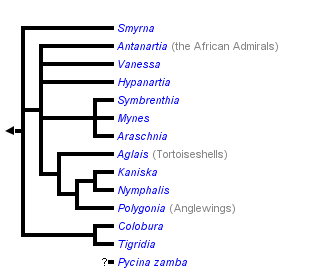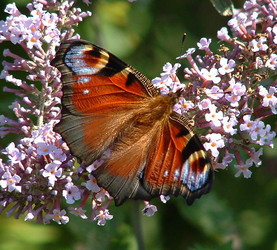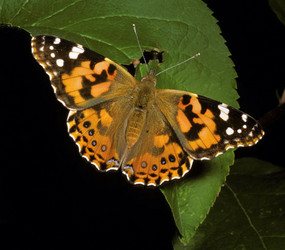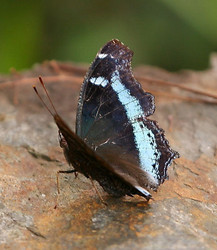Nymphalini
Niklas Wahlberg and Andrew V. Z. Brower


This tree diagram shows the relationships between several groups of organisms.
The root of the current tree connects the organisms featured in this tree to their containing group and the rest of the Tree of Life. The basal branching point in the tree represents the ancestor of the other groups in the tree. This ancestor diversified over time into several descendent subgroups, which are represented as internal nodes and terminal taxa to the right.

You can click on the root to travel down the Tree of Life all the way to the root of all Life, and you can click on the names of descendent subgroups to travel up the Tree of Life all the way to individual species.
For more information on ToL tree formatting, please see Interpreting the Tree or Classification. To learn more about phylogenetic trees, please visit our Phylogenetic Biology pages.
close boxIntroduction
Nymphalini contains about 100 species, many of which are well-known by everybody, such as the Red Admiral (Vanessa atalanta), the Painted Lady (Vanessa cardui) and the Tortoiseshells (Aglais). Species in temperate regions tend to hibernate as adults, and are thus among the first butterflies to be seen in Spring. The group has been the subject of intensive ecological and evolutionary studies, especially the genus Polygonia. Species of Nymphalini are found through out the world, even on remote oceanic islands such as Hawai'i.
Discussion of Phylogenetic Relationships
The phylogenetic relationships of Nymphalini have been studied intensively since 2000, although the emphasis has been on the Nymphalis-group (including Nymphalis, Kaniska, Polygonia and Aglais). The most comprehensive study so far has been done by Wahlberg et al. (2005), who included 46 species from almost all genera (the putative Nymphalini Pycina was not included). Wahlberg et al. (2005) showed that the genera Colobura, Tigridia and Smyrna should be included in the tribe Nymphalini (they were previously placed in Coeini). Colobura and Tigridia are clearly sister genera and together they are sister to the rest of Nymphalini. The position of Smyrna is not clear at the moment, it may be sister to the rest of Nymphalini (to the exclusion of Colobura and Tirgridia; Wahlberg et al. 2005) or it may be sister to Colobura , Tigridia (Wahlberg 2006). The remaining genera form a strongly supported monophyletic group based on the DNA sequences of three genes (Wahlberg et al. 2005). Within this group, Symbrenthia, Mynes and Araschnia form a monophyletic group, but the relationships of these three genera are not clear at the moment (Fric et al. 2004, Wahlberg et al. 2005), with Fric et al. (2004) suggesting that Mynes is within Symbrenthia, while Wahlberg et al. (2005) place Mynes as sister to Araschnia. The lack of resolution is possibly due to the quick divergence of the ancestor into three lineages (Wahlberg 2006).
The positions of Antanartia, Vanessa and Hypanartia are also not clear, with Wahlberg et al. (2005) placing Antanartia as sister to the other genera, and Hypanartia and Vanessa as sister to each other. Traditionally, Antanartia and Hypanartia have been considered to be sister genera, and indeed further unpublished molecular data is indicating that this may be the case (N. Wahlberg, unpublished).
The relationships of the Nymphalis-group genera have been the focus of several studies (Nylin et al. 2001, Wahlberg and Nylin 2003, Weingartner et al. 2006). It is clear that the genus Aglais is sister to the other genera, with strong support from both molecules and morphology. The position of Kaniska is not clear, with molecules placing it as sister to Nymphalis with weak support and morphology placing it as sister to Polygonia, also with weak support. Kaniska was synonymized with Polygonia by Wahlberg and Nylin (2003), however, the unclear position of Kaniska suggests that it should be retained as a genus of its own, despite having just a single species in it.
References
Fric, Z., M. Konvicka, and J. Zrzavż. 2004. Red & black or black & white? Phylogeny of the Araschnia butterflies (Lepidoptera: Nymphalidae) and evolution of seasonal polyphenism. Journal of Evolutionary Biology 17:265-278.
Nylin, S., K. Nyblom, F. Ronquist, N. Janz, J. Belicek, and M. KšllersjŲ. 2001. Phylogeny of Polygonia, Nymphalis and related butterflies (Lepidoptera: Nymphalidae): a total-evidence analysis. Zoological Journal of the Linnean Society 132:441-468.
Wahlberg, N. 2006. That awkward age for butterflies: insights from the age of the butterfly subfamily Nymphalinae. Systematic Biology 55:703-714.
Wahlberg, N., A. V. Z. Brower, and S. Nylin. 2005. Phylogenetic relationships and historical biogeography of tribes and genera in the subfamily Nymphalinae (Lepidoptera: Nymphalidae). Biological Journal of the Linnean Society 86:227-251.
Wahlberg, N., and S. Nylin. 2003. Morphology versus molecules: resolution of the positions of Nymphalis, Polygonia and related genera (Lepidoptera: Nymphalidae). Cladistics 19:213-223.
Wahlberg, N., Weingartner, E., Warren, A. D. & Nylin, S. 2009 Timing major conflict between mitochondrial and nuclear genes in species relationships of Polygonia butterflies (Nymphalidae: Nymphlalini). BMC Evolutionary Biology 9, 92.
Title Illustrations

| Scientific Name | Aglais io |
|---|---|
| Location | UK |
| Specimen Condition | Live Specimen |
| Behavior | feeding on Buddleia |
| Source | Peacock butterfly (Inachis io) |
| Source Collection | Flickr |
| Image Use |
 This media file is licensed under the Creative Commons Attribution-NonCommercial-ShareAlike License - Version 2.0. This media file is licensed under the Creative Commons Attribution-NonCommercial-ShareAlike License - Version 2.0.
|
| Copyright | © 2003 wolf 359 |
| Scientific Name | Vanessa cardui |
|---|---|
| Comments | at rest on leaves of apple |
| Specimen Condition | Live Specimen |
| Life Cycle Stage | adult |
| Source Collection | Bugwood Network/Forestry Images |
| Copyright | © William M. Ciesla, Forest Health Management International |
| Scientific Name | Kaniska canace |
|---|---|
| Location | Taiwan |
| Specimen Condition | Live Specimen |
| Source | IMG_5629ac1 |
| Source Collection | Flickr |
| Image Use |
 This media file is licensed under the Creative Commons Attribution-NonCommercial-NoDerivs License - Version 2.0. This media file is licensed under the Creative Commons Attribution-NonCommercial-NoDerivs License - Version 2.0.
|
| Copyright | © 2006 leemt2 |
About This Page
Niklas Wahlberg

University of Turku, Finland

Middle Tennessee State University, Murfreesboro, Tennessee, USA
Correspondence regarding this page should be directed to Niklas Wahlberg at and Andrew V. Z. Brower at
Page copyright © 2009 Niklas Wahlberg and
 Page: Tree of Life
Nymphalini .
Authored by
Niklas Wahlberg and Andrew V. Z. Brower.
The TEXT of this page is licensed under the
Creative Commons Attribution License - Version 3.0. Note that images and other media
featured on this page are each governed by their own license, and they may or may not be available
for reuse. Click on an image or a media link to access the media data window, which provides the
relevant licensing information. For the general terms and conditions of ToL material reuse and
redistribution, please see the Tree of Life Copyright
Policies.
Page: Tree of Life
Nymphalini .
Authored by
Niklas Wahlberg and Andrew V. Z. Brower.
The TEXT of this page is licensed under the
Creative Commons Attribution License - Version 3.0. Note that images and other media
featured on this page are each governed by their own license, and they may or may not be available
for reuse. Click on an image or a media link to access the media data window, which provides the
relevant licensing information. For the general terms and conditions of ToL material reuse and
redistribution, please see the Tree of Life Copyright
Policies.
- First online 25 September 2006
- Content changed 04 June 2009
Citing this page:
Wahlberg, Niklas and Andrew V. Z. Brower. 2009. Nymphalini . Version 04 June 2009 (under construction). http://tolweb.org/Nymphalini/70222/2009.06.04 in The Tree of Life Web Project, http://tolweb.org/











 Go to quick links
Go to quick search
Go to navigation for this section of the ToL site
Go to detailed links for the ToL site
Go to quick links
Go to quick search
Go to navigation for this section of the ToL site
Go to detailed links for the ToL site